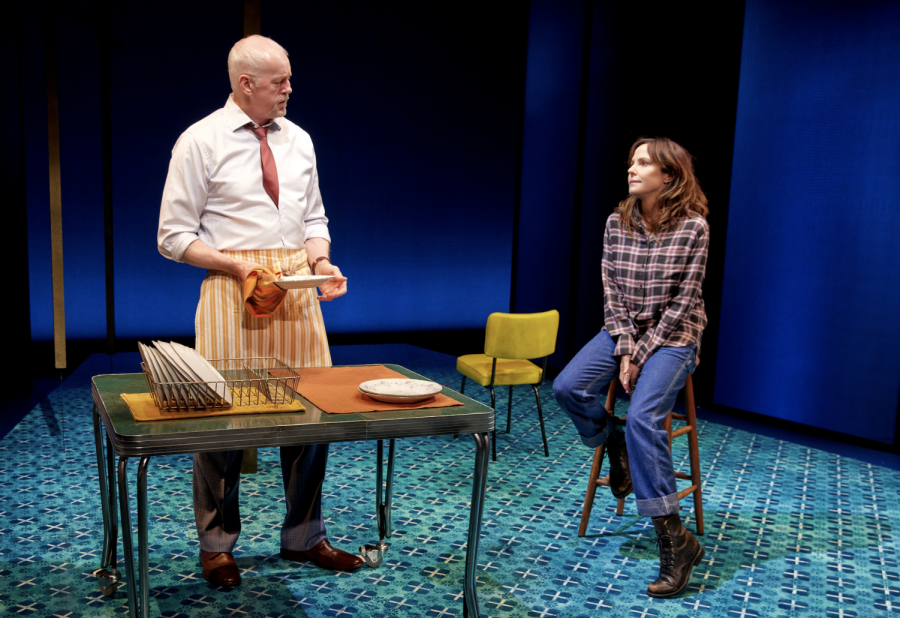‘How I Learned to Drive’ Is a Jaw-Dropping Trip Down Memory Lane
Paula Vogel’s Pulitzer-Prize winning play parks on Broadway where it belongs
COURTESY OF JEREMY DANIEL
“How I Learned to Drive” stars Tony Award winning-actress Mary-Louise Parker, David Morse and Johanna Day, with Mark Brokaw directing.
May 4, 2022
Trigger warning: themes of abuse and pedophilia
“Sometimes to tell a secret, you first have to teach a lesson.”
When Tony Award-winning actress Mary-Louise Parker walked onstage and delivered this line of dialogue as the character Li’l Bit, the audience instantly learned that this is her story to tell.
On the minimalist stage, she describes in great detail the scenery of the parking lot overlooking the Beltsville Agricultural Farms in suburban Maryland in 1969. She even points out the projected moon that flashes to life at her command. She is a soft-natured, seasoned woman welcoming us into her space — until she isn’t. Li’l Bit appears to be a well-endowed woman before she mentions “a man old enough to be —” and doesn’t finish the thought. She begins as Li’l Bit in the present day, after which she folds into the cynical, 17-year-old girl being violated by her uncle.
“How I Learned to Drive,” the Manhattan Theatre Club production currently playing at the Samuel J. Friedman Theatre located at 261 W. 47th St., is not for the faint of heart but is a masterclass in theater-making and tackling trauma.
Originally scheduled for the 2020-21 season, the play is no stranger to the stage. It premiered off-Broadway at the Vineyard Theatre in 1997, with playwright Paula Vogel taking home the Pulitzer Prize for drama the following year. The first professional production of the play in New York City was in 2012 at Second Stage Theatre.
Twenty-five years later, original director Mark Brokaw returned alongside original cast members Parker, David Morse and Johanna Day to finally see the show have its Broadway debut.
The story takes us through Li’l Bit’s complex relationship with her aunt’s beloved husband, Uncle Peck (Morse), in a non-chronological fashion as she tries to come to terms with the hurt that has been inflicted upon her from the age of 11 up until her first year of college.
Parker perfectly embodies and distinguishes every age of Li’l Bit with subtle physicality shifts to make the story flow in and out of time fluidly.
The memories unfold through the structure of a driving lesson, with a three-person Greek chorus — made up of Teenage (Alyssa May Gold), Male (Chris Myers) and Female (Day) — adopting the roles of outside influences, like Li’l Bit’s grandparents and classmates.
In this New York Times critic’s pick, Parker and Morse take on the challenge of harnessing these conflicted, deeply human characters in their soul and rise to the occasion. Both give legendary performances that will go down in history.
While it takes a moment or two to get used to, Parker perfectly embodies and distinguishes every age of Li’l Bit with subtle physicality shifts to make the story flow in and out of time fluidly. She seamlessly transforms from a smart-mouthed 17-year-old to a haunted adult teacher to a big-hearted 11-year-old. I still don’t know how she does this despite seeing it right before my eyes in the 1-hour and 40-minute performance (with no intermission).
Morse’s depiction of the troubled, hardworking man paints a picture of a charmer that the audience could easily fall for if they were not aware of the whole story.
The audience almost knows what age she is before the text reveals it, yet we don’t want to admit it to ourselves due to how disturbing it is. When it is communicated, like late into a scene where Uncle Peck takes photos of a 13-year-old Li’l Bit in his basement and tries to convince her to become a Playboy model, we’re still just as shocked and uncomfortable in our cushioned seats as we have been for the entire show.
Each scene feels like something we shouldn’t be watching, but this is Li’l Bit’s secret to tell. And if we didn’t stay to witness the moments unfold, we’d be just as complicit as the bystanders in her life, like her mother and Aunt Mary who were revealed to have known of the abuse (both played by Day).
Morse also does sophisticated work here that is evident of the years he has had to dig into Peck’s psyche. The Southern veteran and former alcoholic is never given a pass for his predatory behavior, but Morse’s depiction of the troubled, hardworking man paints a picture of a charmer that the audience could easily fall for if they were not aware of the whole story. Peck devolves into a trainwreck the audience can’t turn away from, culminating in a climax that garnered audible gasps from the audience.
Parker and Morse steal the show, but the remaining ensemble shouldn’t be underestimated. Day delivers a great monologue as Aunt Mary, trying to defend her husband, which sends chills down the audience’s spines. In another scene, Li’l Bit’s mother discusses her suspicion of her brother-in-law’s intentions with her daughter. I would not have minded if she remained as these two characters for the entire show.
Gold and Myers serve more as tools for world-building than fully fleshed-out characters, just as the script calls for. Most notably, Brokaw’s decision to use the youngest actors to portray Li’l Bit’s grandparents struck me. Both actors are new to the Broadway stage, especially Myers who is making his Broadway debut, and their freshness alerts me to the intergenerational trauma within Li’l Bit’s family.
Vogel’s rich text is filled with little details that can be analyzed throughout hundreds of readings, and without this direction, I wouldn’t have remembered that Li’l Bit’s grandmother was taken from her home to be a child bride at only 14 despite cries from her older sisters. Gold’s portrayal of the grandmother caused me to question the way society views sexuality and gendered power dynamics.
Li’l Bit’s journey with trauma and healing is written with such nuance that only other survivors will notice at times.
Brokaw’s direction in general focuses more on smaller gestures, rather than bigger ones. There’s limited physical contact with a dedicated focus on the distance between the actors.
Some scenes have Parker’s Li’l Bit watching Morse’s Uncle Peck mime out actions with an invisible scene partner as if she’s watching herself from inside the memory. Through this memory choreography, the audience watches Li’l Bit attempt to form a relationship between her current adult self and her wounded child self, reminiscent of therapeutic inner child work.
With all that said, what shines here first and foremost is the writing of the play itself. The treatment of its heavy material is careful and considerate. Vogel isn’t here to traumatize the audience or get a dramatic reaction just for the sake of it. She instead gives a voice to all those in similar situations who have been silenced or haven’t been able to find their voice quite yet.
In a note she leaves in the playbill, she admits that she doesn’t know if she will write something that connects to such a wide demographic again, and I believe that to be true.
Li’l Bit’s journey with trauma and healing is written with such nuance that only other survivors will notice at times. And as Li’l Bit concludes her story with ghosts in her backseat, a disconnect from her body but a vehicle that offers hope for freedom, I can only wonder where I stand with my own secrets.
“How I Learned to Drive” opened on April 19 and will continue to run as a limited engagement through May 29.














